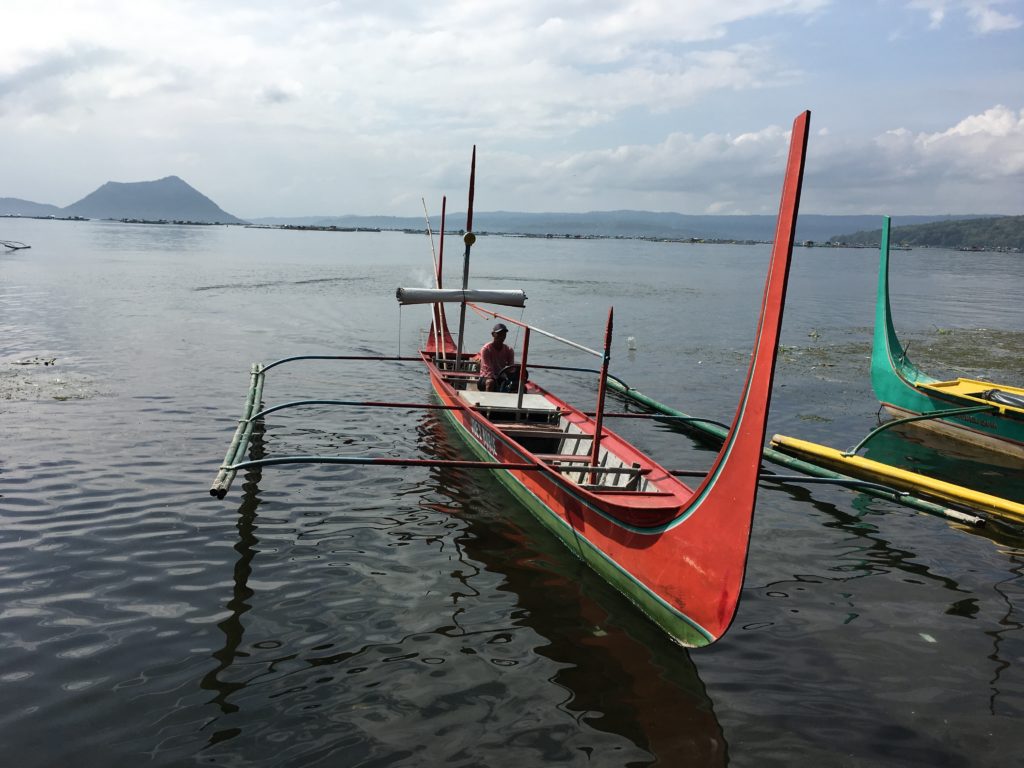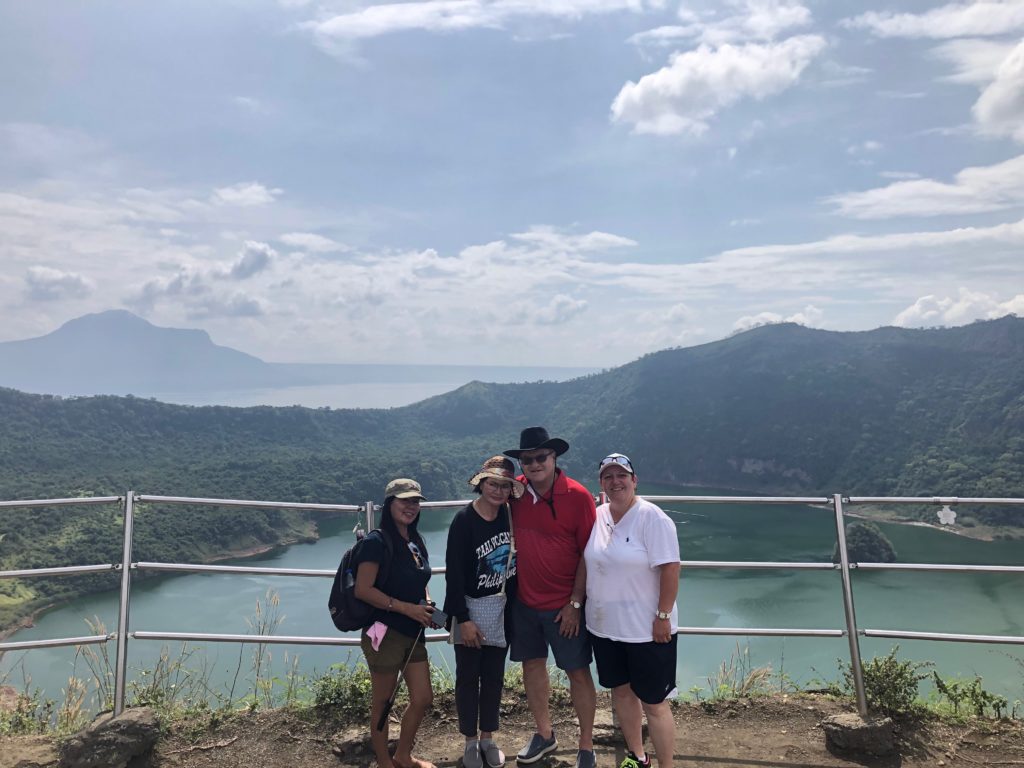It was not a quiet week in Tagaytay.
My friend Sandi arrived for a visit from Canada, by way of Hawaii, New Zealand and Sydney. It was Monday evening as Typhoon Tisoy was beginning to reach landfall in the Visayas that morning and heading north, expected to hit Luzon Tuesday. As I reported last week, the media get excited about potential catastrophes, in Philippines as much as anywhere, and people get inured to all this drama: Two Typhoons in 10 days that ended up being nothing more than tropical storms, and they went almost unnoticed here in Tagaytay, makes you a bit cynical. But by Tuesday dawn Tisoy was wailing away. Our unit is on the fifteenth floor of a 24 story building, which gives you pause to think, but apparently Wind Residences are built to withstand nature’s calamities: typhoons and earthquakes; no need to worry about floods and tsunamis. When the wind was howling at 5:30 in the morning we had to admit, this was not just another false alarm, or exaggerated warning. And for proof I got email messages from the Canadian Consulate offering alerts and advice. There was nothing much to do but get out of bed and watch the patio doors rattle, wondering if they might actually collapse. The storm was apparently Category 2, or maybe 3, when it hit land and winds gusting to 150kmh or higher. The driving rain almost completely obscured the view of the lake; there were no cars on the road, only the occasional police car with blue lights flashing. The blessing was that I didn’t have to contend with the noisy jeepneys. But wouldn’t you know it, the rooster screamed at the typhoon all day long. The power had gone out in the city early in the morning but the buildings’ back-up power supply kicked in seamlessly. However, that was good for only as long as the diesel tanks lasted. About six hours as it turned out, even with the elevators shut down. But, migawd the internet went down! More than once! At times I wondered if we should leave the apartment for the ground level but was assured there was no need – the storm wasn’t that serious. I wondered when it might be considered serious – Category 5?

The storm continued all day – we had not made any plans for the day to allow Sandi to recover from her day-long travels on Monday, and so we had some lovely bonding in our tiny apartment, conversation and reading, chestnuts roasting at an open fire, and so on, nervously glancing at the rattling windows. Feeling a bit of cabin fever we decided to check out Pizza Hut in the next building for a little lunch. The walk down fifteen flights of stairs was not onerous but we certainly hoped the elevators were back in service when we had to make the return trip. They weren’t. Oh well, we weren’t going to make it to the gym today anyway. Things got interesting around 1:30 when the auxiliary power went out. Now we hoped that power could be restored before 5:30, because it will be very dark by then, and no flashlights or candles. At least the wind had died down. But not the rooster.
The storm wailed all through the night into Wednesday then gradually abated. By noon the sun broke out and you’d hardly know there had been a storm at all, except for the downed trees and power lines and bits of peoples’ huts scattered in the fields and ditches. We could still salvage something of our day but not our trip Lake Taal Island and volcano. Maybe Thursday.
We called our wizard driver, Romel, and told him we would flip Wednesday’s plan for Thursday’s plan – it would be the Spanish 19th century town of Taal instead [pronounced Ta-al].
We anticipated colonial Taal would an interesting enough experience itself but the drive from Tagaytay to Taal was, um, awesome. As I mentioned in an earlier newsletter, Lake Taal is actually a huge caldera created from multiple eruptions over multiple millennia. The ridge is 2000 feet above sea level and a thousand feet above the lake level. Before 1754 Lake Taal wasn’t even a lake, it was part of Balayan Bay. A major explosion of the volcano blocked the entrance to the bay and Taal became a lake (and eventually the water transformed from salted to fresh). So the drive along the ridge was quite spectacular with the lake on one side and the ocean bay on the other, the tops of coconut palms far below us.
The original village of Taal was obliterated along with its 17th century churches and houses, a modern day Pompei if ever excavated. The ‘new’ village of Taal was rebuilt further west on the shores of the re-formed Balayan Bay with an even greater cathedral. The streets are narrow and all the Spanish houses are obliged to be maintained in the original fashion, at least on the outside. (‘Maintained’ is Fiipino license for ‘still standing’; this is a poor country and everything is rather ragged and worn.) Taal is more than a living museum, it’s a real town: the basilica may be the highlight but the locus is the market area of half a dozen blocks of tiny shops. Carmen and her best friend Lani, and Sandi worked the alleys, I was a willing bystander, watching Carmen drive bargains with the shop keepers.
Lake Taal Volcano was Thursday’s agenda. And it was a very active outing, and not just because Lake Taal volcano has been showing signs of activity, actively monitored by the Philippine Institute of Volcanology and Seismology: daily quakes of magnitude 1 to 3 (almost unnoticeable), and increased emisions of CO2 and SO4. The last major eruption was in 1969 when 1600 people died, not sure how many horses. Human habitation is prohibited on Lake Taal Island – only 6000 people live there now. Like Lake Taal itself the volcano in the island is ‘dormant’, but the evidence sems to suggest something else. I hope we’re not on the verge of the next big thing, though nobody seemed concerned.
Our trusty driver/guide Romel, drove his trusty Izusu van with his trusting passengers down another fascinating mountain cliff road with multiple twists and hairpin turns, made even more exciting by the sudden appearance every other turn of branches, mud and debris all along the road, detritus from Typhoon Tisoy Tuesday. We arrived safely at the bottom in the lakeside village of Talisay and soon were at a little launching site for our boat trip to the island. We were introduced to our guide for the day, 32-year-old Maiel, a native of the island. We ordered our lunch from the little family kitchen to be ready on our return from the island. We bundled into the banka, the traditional Pilipino outrigger boat, and shoved off. It’s about a 30-minute trip across to the island, but the water was smooth and the trip very pleasant, especially as compared to the drive down the mountain, and the subsquent horseback grind up the hill to the top of the volcano.
Lake Taal is a giant caldera, and Taal Island a secondary crater in the volcano. (In fact this island is made of up of at least another 43 craters, even though some of these are quite small.) The main crater in the island holds another lake, the lake in the island in the lake. This crater lake was our objective for the day; it turned out to be about as appealing as a witches cauldren, boiling water, steam vents and the faint wiff of hydrogen sulfide gas. But it was worth it. One is unlikely to experience anything quite so dramatic and unusual in this world. The Volcano was pretty exciting too.
Enough of my words, let a few pictures tell their own tale.




Friday was a planned down day and much needed it was. But it was not without its own Pilipino experience for our guest Sandi: a Jeepney ride to the local mall for some shopping and a spa, and then a ride back to a wonderful dining experience: The Bag of Beans Charito Restaurant (not sure why it’s called that, it’s not a coffee shop!) overlooking Lake Taal.


But we were packed and ready for our trip into Manila for the weekend and hit the hay early. And I think I shall leave that for next weeks newsletter.
As I said, it was not a quiet week in Tagaytay.
